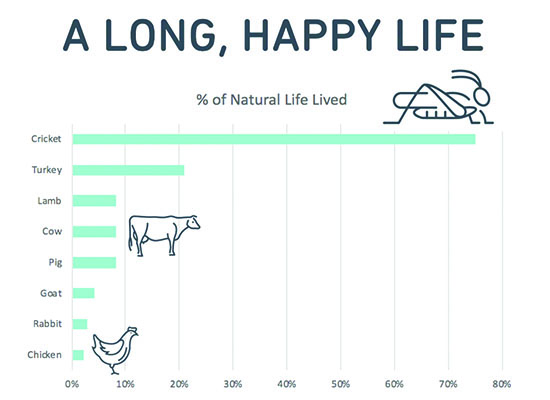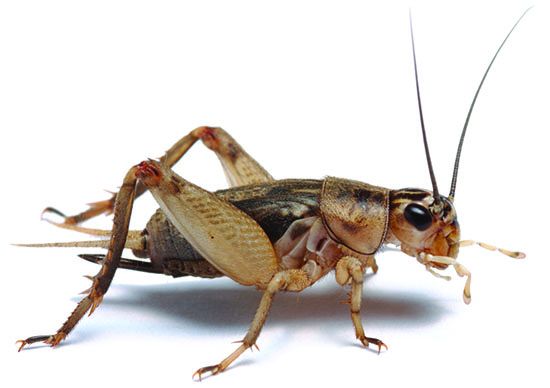What if we could give millions of pets a healthier, happier life and, in the process, make our planet healthier, too?” That’s the question that a pet food company called Jiminy’s was founded to answer back in 2016. Jiminy’s hoped to meet this lofty goal by replacing conventional sources of animal protein (such as chicken and beef) in its dog food with protein obtained from commercially grown crickets.
Yes, crickets. According to the calculator provided on Jiminy’s website, replacing a 50-pound dog’s beef-based food for one year with a cricket-based food containing the same amount of protein would save almost 3 million gallons of water, reduce the production of greenhouse gases equivalent to driving an average car more than 4,000 miles, and use 23 acres less land.
THE COSTS OF PROTEIN PRODUCTION
Protein is, of course, a critical component in dog diets. Animal-sourced proteins are the most commonly used proteins in pet food. In 2021, a report commissioned by the American Feed Industry Association’s Institute for Feed Education and Research, the Pet Food Institute, and the North American Renderers Association estimated that U.S. pet food manufacturers purchase 6.9 billion pounds of animal protein per year (report quoted by Pet Food Processing magazine).
According to a study published in 2017 by a researcher at the University of California – Los Angeles, dogs and cats are responsible for 25% to 30% of the environmental impact of meat consumption in the U.S. American pets consume more meat than humans in most countries worldwide.
The production of all those food-animal proteins has an enormous impact on the planet. Beef production is the largest driver of deforestation in South America. Producing a kilogram of beef causes the emission of almost 100 kilograms of greenhouse gas; by comparison, the production of one kilogram of peas results in a little less than one kilogram of greenhouse gas emissions. The production of both food animals and the food that must be produced to feed the food animals requires massive amounts of water; it’s estimated that 70% of all the freshwater withdrawals on the planet go to agriculture.
INDUSTRY RESPONSE
Jiminy’s may have gone further than any other company to directly address the environmental impact of pet food production, but it isn’t the only company making these calculations; the entire pet food industry has sustainability on its mind.
With an ever-growing global human population, there is ever-increasing competition for ingredients that can sustain humans and their pets alike. That causes the cost of the nutrients that dogs require to continually increase – and the cost of dog food to rise accordingly.
Pet food makers have a number of different tactics for meeting their consumers’ needs for protein. Each of these protein sources offer benefits and pose concerns for both the canine consumers they are made for and the planet. Most use a combination of the following:
- Human-edible animal-source proteins
- Meats and meat by-products that are not human-edible
- Plant-sourced proteins
- Insect-sourced protein
Historically, we’ve advocated for what we believe is nutritionally healthiest for dogs – the use of the highest-quality animal-protein sources that dog owners can afford – to the exclusion of all other factors (and that will continue to be the primary selection factor in our dog food reviews). After all, the amino-acid profiles of animal-sourced proteins more perfectly meet dogs’ nutritional requirements than plant-sourced proteins.
But perhaps we should all consider, at least once, the deleterious effect on the environment of producing all of that food – just for our pets. If the most dire predictions about climate change come to pass, dogs in the future will be fed very differently than they are now.
We know more than a few vegans and vegetarians who own dogs. Some feed their dogs vegan or vegetarian diets, not wanting to support the production and death of any food-source animals, even for their own dogs’ benefit.
Others feed their dogs conventional foods that contain animal-sourced proteins. A subset of these friends buy only those dog foods that offer third-party certifications that the meat sources used in the foods were humanely raised and/or wild-caught.
We’re not vegetarians nor vegans, but we’ve always admired the concept of “humanely raised” meats, and have sought to support companies that offer products with humane certifications. But we’d never before seen the particular animal-welfare consideration illustrated in this graphic, which we found on the Jiminy’s website:

Jiminy’s calls their food and treats “humane” partly because the insects used as the primary protein source in their products are able to live for a far greater percentage of what would otherwise be their natural life than any other food-species animals.
Jiminy’s also considers its products humane because of the way insects used in the food are raised and harvested. According to the company, “Crickets are naturally a swarming species and like being in a dark, warm place. They’re raised in cricket condos (inside barns) which allow the crickets to live in a way as close as possible to how they would live in the natural world. They are free to hop from feed station to feed station and can burrow deep into the condos if they choose. Harvesting time comes near the end of their natural life cycle – which is approximately 6 weeks. This comes after they have mated and laid their eggs. At the end, temperature is lowered and they go into a hibernation-like state before they’re harvested.”
HUMAN-EDIBLE MEATS AND MEAT BY-PRODUCTS
The phrase “edible” confuses everyone; isn’t all food edible? Well, no; not by the official definition of the word in this country. According to the United States Department of Agriculture (USDA), the word “edible” means that it’s wholesome (untainted and fresh) and safe for humans to eat. People often use the phrase “human grade” to describe the same type of ingredient as “edible” but “human grade” has no legal definition.
“Meat” has a legal definition, and it refers to the muscle tissue of food-source animals.
There are a number of edible meat by-products (sometimes referred to as “offal”); these are non-muscle parts of slaughtered animals that are eaten but have been cut from a dressed carcass. These include foods such as liver, tongue, hearts, and pigs feet.
Human-edible animal-source proteins are among the most expensive ingredients that pet food makers have at their disposal. Since they have to pass the same inspections as for the foods we eat, they are as wholesome and nutritious as possible. They are kept clean and chilled throughout processing.
There are a very few products made for pets in human-food manufacturing facilities (see “Human Grade Dog Food,” WDJ December 2021”). There are probably more pet food makers that use human-edible meats in their products (mostly refrigerated and frozen diets), but unless the products are made with 100% human-edible ingredients in USDA-inspected human-food manufacturing plants, they cannot make “human-grade” claims on their labels or marketing materials.
Of all the protein sources available to pet food makers, meat and meat by-products have the greatest deleterious effect on the environment.
“NON-EDIBLE” MEATS AND MEAT BY-PRODUCTS
Non-edible meats include those that didn’t pass inspection for human consumption or have passed their sell-by date. Meat by-products include many nutritious parts of the animal that humans don’t typically eat, including organs, stomachs, intestines, bones, and poultry “frames” (what’s left of a bird after the feet, wings, neck, head, organs, and most of the meat have been removed). Blood, collected from freshly killed animals before they are butchered, is also considered a meat by-product.
Some meat by-products are used in canned, fresh/refrigerated, and frozen pet foods. Most meat by-products, however, are rendered – subjected to a process that separates the fat from the proteins, removes most of the moisture, and kills any pathogens present; the result is a low-moisture meal. According to the North American Renderers Association, without rendering, roughly 50% of each meat animal would go to waste.
We’ve recently become convinced of the value of a meat by-product that we were strongly opposed to in the past: spray-dried porcine and bovine plasma. Blood is collected in slaughterhouses that are specially equipped for its capture. The blood is chilled and transported in food-grade, species-dedicated tank trucks to processing plants where it is treated with ultraviolet photopurification, centrifuged (to remove red and white blood cells), concentrated, and dried.
Plasma contains albumin proteins with bioactive peptides and immunoglobulin G (IgG). Studies indicate that its inclusion in canine diets support immune and gut health. It’s been used as a thickener in canned foods for some time, often disguised under another of its legal names, “natural flavor.” Increasingly, it’s being added to dry dog foods as a palatant (reportedly, dogs love its taste) and protein booster.
Over the years, mankind has gotten increasingly inventive in finding uses for by-products of the meat industry. If these materials went unused, it would make the environmental impact of their production even more egregious than it is.
PLANT PROTEINS IN DOG FOOD
There are a number of protein-containing grains and legumes (and grain and legume by-products) used in dog food production. Some have been used for many decades; others are just emerging as potential replacements for animal-protein sources. The most commonly used plant proteins used in pet food include:
- Algae (aquatic plant)
- Beans
- Brewers dried yeast
- Chickpeas
- Corn
- Duckweed (aquatic plant)
- Fava beans
- Lentils
- Lupin beans
- Peas
- Potatoes
- Quinoa
- Rapeseed
- Rice
- Soybeans
- Sunflower seeds
- Wheat
The environmental impact of growing all of these plant sources of protein is far less than that of producing an equivalent amount of animal protein. However, more care must be taken to ensure the resulting products are formulated to fully meet the dog’s nutritional needs – the amino acids in particular.
Another drawback of foods that contain only plant-sourced proteins is that they tend to be far less are less palatable to dogs. According to Pet Food Industry, characteristic off-flavors from plant proteins in pet food include bitterness and astringency.
Finally, plant-derived protein sources also carry the risk of mycotoxins – toxins that are produced by fungi that can infect certain plants. The higher the inclusion of ingredients that can be contaminated with mycotoxins, the higher the risk of mycotoxin poisoning.
INSECT-SOURCED PROTEIN DOG FOOD
As previously mentioned, crickets are being used by Jiminy’s in treats and its “Cricket Crave” dog food. Cricket protein is reportedly more expensive than any animal protein, but as more entrepreneurs figure out cricket farming, and more commercial cricket farms come onto line, the price of this unique protein will descend.
Cricket protein production has an exponentially smaller carbon footprint and less water consumption than conventional animal protein production. Nutritionally, it has some other advantages: It’s highly digestible, exceeds the amino acid requirements set by the Association of American Feed Control Officials (AAFCO), and (due to its fiber content), functions as a prebiotic (a microbial food source that promotes the growth of beneficial bacteria in the gut).
Jiminy’s also uses another protein sourced from dried larvae of the black soldier fly. Nestlé has announced it’s launching a pet food that contains this protein, initially to be sold only in Switzerland, and there are several other foreign pet food manufacturers offering dog food containing insect meal. These foods are promising, but given their newness and dearth of feeding trials, we’d recommend using them only in rotation with more conventional diets.






